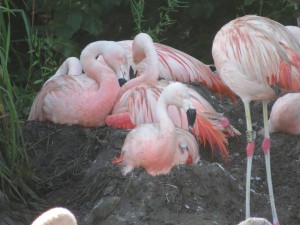Flamingos in the pink!

*Toots a fanfare*...hello and welcome to WWT Washington's first Chilean flamingo chick of the season!
It arrived on Saturday 5 September and is now quite visible on the nest, with its parents already encouraging it to stand and stretch those new little legs.
There are three more eggs still to hatch so fingers - and wings! - crossed that they arrive safe and sound.
This is the second year in a row that our flock has laid its own eggs following a seven-season hiatus, during which our team of staff and volunteers hand-reared 29 flamingo chicks to be integrated with the existing birds in a bid to encourage them to breed naturally.
Which they did! Clever flamingos.
Hear more about their journey during our daily talks at 11.45am and 3.15pm.
[video width="1280" height="720" mp4="https://www.wwt.org.uk/blog/wp-content/uploads/2015/09/WWT-Washington-first-flamingo-chick-of-2015-hatched-5-Sep.mp4"][/video]
Did you know?
- There are six species of flamingo: greater, Caribbean, Andean, James’, Chilean and lesser.
- Flamingos have been part of the Wildfowl and Wetlands Trust’s breeding programme for more than 45 years and part of WWT Washington’s collection since 1986.
- Today, WWT has more than 600 flamingos at four of its wetland centres – all species at WWT Slimbridge, Chilean and greater at WWT Martin Mere, Caribbean at WWT Llanelli and Chilean at WWT Washington.
- Flamingos nest in large groups and live in even larger groups called colonies, which can be home to between 10,000 and one million birds at a time.
- Flamingos can live to more than 60-years-old and still breed.
- Their knees look as if they bend backwards, but this is actually their ankle with a very long foot attached. Their knees are tucked high up beneath their bodies.



